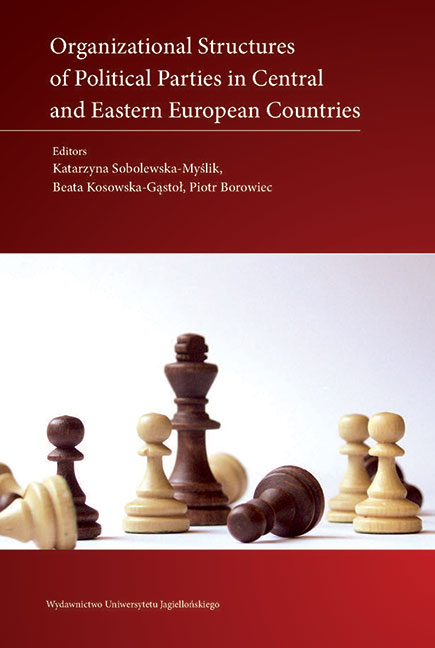Book contents
- Frontmatter
- Contents
- Preface
- Developing Party Structures in Central and Eastern Europe
- Albania: Organizations of Political Parties in Albania
- Belarus: Belarusian Political Parties: Organizational Structures and Practices
- Bosnia and Herzegovina: Organizational Structures of Political Parties in CEE Countries: A Case Study on Bosnia and Herzegovina
- Bulgaria: Organizational Structure and Trends in Bulgarian Party Politics
- Croatia: Organizational Structures of Political Parties in Croatia
- Czech Republic: Between Organizational Extremes: Czech Parties after a Political Earthquake
- Estonia: Organizational Structures of Political Parties in Estonia
- Hungary: Cut from the Same Cloth? A Comparative Analysis of Party Organizations in Hungary
- Kosovo: Structure of the Main Political Parties in Kosovo
- Latvia: Leader-Centered and Power-Hungry: Party Organizations in Latvia
- Lithuania: Organization of Political Parties: The Case of Lithuania
- Moldova: Organizational Structures of Political Parties in The Republic of Moldova
- Montenegro: Party Organization in Montenegro: Structural Resemblance Behind Political Divergence
- Poland: Structures of Polish Political Parties in the Second Decade of the 21st Century
- Romania: The Internal Organization of Romanian Political Parties
- Russia: Parties with Roots Growing Upwards: Organizational Features of Russian Political Parties
- Serbia: Organizational Structures of Political Parties in Serbia
- Slovakia: Organizational Structures of Political Parties in Slovakia: Parties not for Members
- Slovenia: Almost without Any Innovations: Organizational Structures in Slovenian Parties
- Ukraine: Shallow Party Structures in a Volatile Party System
- Comparing Organizational Structures of Political Parties in Central and Eastern European Countries
- Biographical notes about the authors
Croatia: Organizational Structures of Political Parties in Croatia
- Frontmatter
- Contents
- Preface
- Developing Party Structures in Central and Eastern Europe
- Albania: Organizations of Political Parties in Albania
- Belarus: Belarusian Political Parties: Organizational Structures and Practices
- Bosnia and Herzegovina: Organizational Structures of Political Parties in CEE Countries: A Case Study on Bosnia and Herzegovina
- Bulgaria: Organizational Structure and Trends in Bulgarian Party Politics
- Croatia: Organizational Structures of Political Parties in Croatia
- Czech Republic: Between Organizational Extremes: Czech Parties after a Political Earthquake
- Estonia: Organizational Structures of Political Parties in Estonia
- Hungary: Cut from the Same Cloth? A Comparative Analysis of Party Organizations in Hungary
- Kosovo: Structure of the Main Political Parties in Kosovo
- Latvia: Leader-Centered and Power-Hungry: Party Organizations in Latvia
- Lithuania: Organization of Political Parties: The Case of Lithuania
- Moldova: Organizational Structures of Political Parties in The Republic of Moldova
- Montenegro: Party Organization in Montenegro: Structural Resemblance Behind Political Divergence
- Poland: Structures of Polish Political Parties in the Second Decade of the 21st Century
- Romania: The Internal Organization of Romanian Political Parties
- Russia: Parties with Roots Growing Upwards: Organizational Features of Russian Political Parties
- Serbia: Organizational Structures of Political Parties in Serbia
- Slovakia: Organizational Structures of Political Parties in Slovakia: Parties not for Members
- Slovenia: Almost without Any Innovations: Organizational Structures in Slovenian Parties
- Ukraine: Shallow Party Structures in a Volatile Party System
- Comparing Organizational Structures of Political Parties in Central and Eastern European Countries
- Biographical notes about the authors
Summary
Introduction
In the last 25 years since the transition to democracy, the party system in Croatia has developed into a rather stable political institution, at least compared to other countries in Central and Eastern Europe (Enyedi and Casal Bértoa 2013). Stability is not only indicated by institutionalization of a system of party competition (e.g. volatility, ENPP, ideological polarization, etc.), but also by institutionalization of party organizations. The two major political parties are the same organizations that participated in the founding democratic elections in 1990 (Čular 2001: 127–130). Party splits and mergers have not endangered their continuity. The entry of new political parties into the party system has been gradual and limited – far from the rapid electoral success of newly formed organizations such as in Slovenia or the Czech Republic in recent years. Party membership has been rather stable and comparatively high (around 10% of registered voters) throughout the whole period (Čular and Nikić Čakar 2014). Major parties have spread their territorial organization to almost all local administrative units, and nationally relevant political parties (either independently or in coalitions) control around 80% of local candidacy, 85% of votes, and almost 90% of all seats in local councils. Around 40–45% of voters have developed a strong party identification (Čular 2005: 140–141; Henjak 2011), which is especially pronounced in the case of the Croatian Democratic Union (HDZ), whose sympathizers make up 60–70% of all HDZ voters. In a word, parties in Croatia are durable and stable organizations.
This does not however, mean that the party system dynamic is nonexistent. In contrast to relative stability at its core, there is a considerable flux on the edges of the party system. At the moment, there are 149 registered political parties in Croatia, and between 55 and 65 parties have regularly competed in each parliamentary election, since 2000.
- Type
- Chapter
- Information
- Organizational Structures of Political Parties in Central and Eastern European Countries , pp. 109 - 132Publisher: Jagiellonian University PressPrint publication year: 2017



